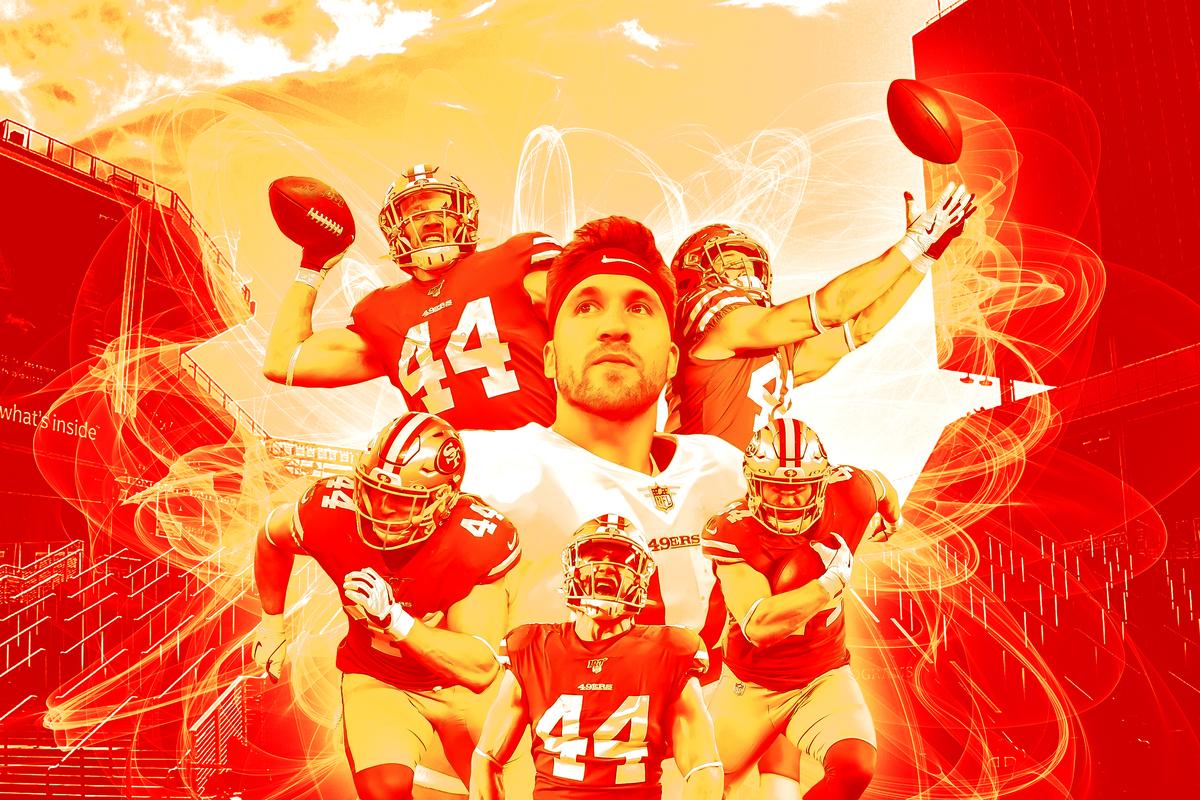
Kyle Juszczyk isn’t your typical fullback. The Harvard product may be listed at “FB” on the 49ers’ depth chart and spend most of his snaps lined up as a lead blocker, but he’s much more than a human battering ram. Kyle Shanahan explained it best in October, after Juszczyk suffered a knee injury that was projected to keep him out for a month. “You don’t replace Kyle,” the 49ers head coach lamented. “He’s one of a kind.”
Because of the variety of roles he occupies in Shanahan’s system, the Niners had to use multiple players to fill the void Juszczyk left. No. 3 tight end Ross Dwelley took over his fullback duties as a lead blocker out of the backfield, while Levine Toilolo saw increased snaps in two–tight end sets. But even that couldn’t truly replicate what Juszczyk brings to the table. As the Niners offense has expanded in its third season under Shanahan, San Francisco’s do-it-all weapon has become one of the most versatile players in the NFL. And his ability to seamlessly transition between roles gives the Niners an air of unpredictability that’s become central to their success.
When Juszczyk signed a market-shattering deal with the 49ers in 2017, some balked at the final numbers. His $5.25 million average annual value is 42.4 percent higher than that of any other fullback in the league. But while that may seem like a drastic overpay, Shanahan and general manager John Lynch had a clear vision for how they would deploy Juszczyk within the Niners’ diversified offense. And this season, that vision has become reality.
During the NFC championship game, Juszczyk lined up in a different spot on the Niners’ first eight offensive plays. He started the game on the left of quarterback Jimmy Garoppolo in a split-back, shotgun formation. On the next snap, he was in a three-point stance next to the left tackle as an inline tight end. One play later, he was situated as a traditional I-formation fullback. When I asked Juszczyk after that game how many different spots he’s lined up in this year, he had a simple yet staggering answer: All of them. “It’s however many different positions there are on the field: wide, slot, tight, backfield—on both sides,” Juszczyk says. “Outside of the QB, I probably have to know the most [about the offense].”
As San Francisco has shifted to a more run-heavy approach in the playoffs, Juszczyk has embraced his role as a traditional blocking back. He isn’t a devastating bruiser in the run game like teammate George Kittle, but Juszczyk consistently gets the job done as the lead blocker in San Francisco’s two-back schemes. During the regular season, the Niners used two-back sets on a league-leading 28 percent of their snaps. On those plays, San Francisco averaged a robust 5.7 yards per carry.
What Juszczyk lacks in pure power, he makes up for in athleticism. Take this run from the first half of the NFC title game. At the snap, Juszczyk initially takes an exaggerated step to his right in order to get width ahead of the outside toss to Raheem Mostert. As Za’Darius Smith crashes hard inside, though, Juszczyk has to quickly redirect and wall off the Packers’ star pass rusher as he darts into the backfield. It’s not some bone-crunching block, but Juszczyk’s ability to adjust midstream allows him to seal Smith and let Mostert get the edge.
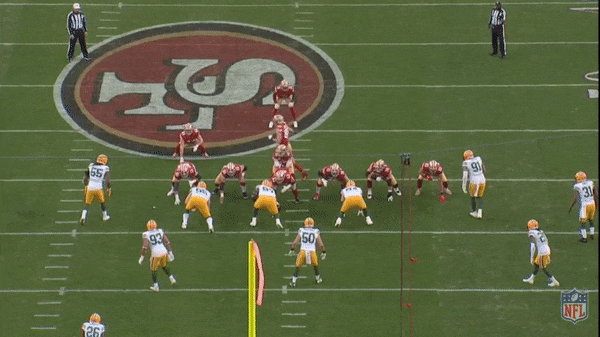
Over the second half of the season, the Niners have used a ton of split-back sets from the shotgun that are slight alterations of their core run-game concepts. The setup may look entirely different to the defense than standard two-back packages under center, but for San Francisco, it’s just a simple way to tweak the same old runs. “Really, it just gives us the ability to run I-formation in shotgun,” Juszczyk says. “Sometimes it’s more advantageous to be in the gun. RPOs are easier to read [in shotgun]. You get lateral on wide zones because the back’s track is more straight down the line.” Along with slight variations on its trademark zone runs, the split-back look also gives San Francisco another way to execute the gap and power runs that Shanahan has used more this season than ever before. “Guys have to play more lateral [against zone runs],” Juszczyk says. “And when you’re playing lateral, it just sets yourself for gap schemes. Typically, a wide zone, you don’t picture it as aggressive. You don’t picture the offensive linemen getting into the defensive linemen as you would in a gap scheme. I think you can shock people.”
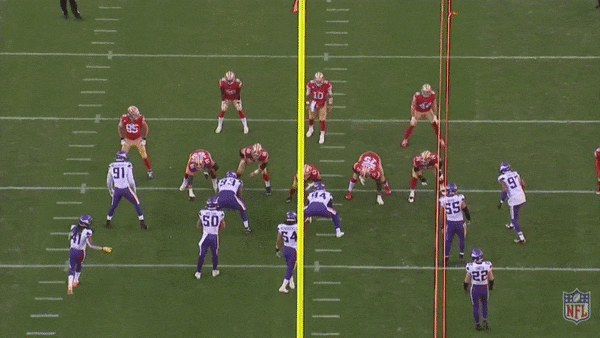
That knack for toying with a defense’s expectations is the foundation of what makes Juszczyk so useful to the Niners offense. His movement skills in the run game allow the Niners to try blocking schemes that other teams wouldn’t even consider, and those wonky wrinkles add layers of deception to an offense that’s already tough to figure out. My favorite Juszczyk play from the NFC championship game came on a big run by Deebo Samuel in the second quarter. The Niners are lined up in a heavy 22 personnel package (two running backs, two tight ends, and one wide receiver) with Juszczyk as an I-formation fullback. Juszczyk shuffles in motion to the right, and at the snap, he flies across the formation toward Smith on the left edge. This type of action would typically indicate a power play in San Francisco’s scheme, but instead of kicking Smith out, Juszczyk gives a quick head fake and peels around to the outside. It’s a sneaky move designed to play on Smith’s assumptions, and it works like a charm. Bracing for contact, Smith squeezes down hard and gives Samuel a wide-open path to the corner for an 11-yard gain.
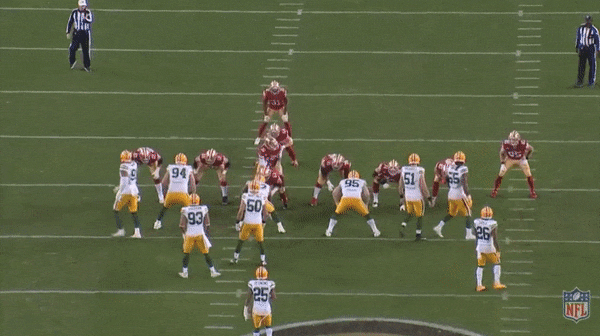
Trickery like this showcases why it’s such a pain in the ass to play against Juszczyk and this offense. Every time a defender reacts to a movement or action with any sort of conviction, there’s a chance that he’s about to look pretty damn silly. The Niners’ illusions have become so complex that opposing defenders have even approached Juszczyk after games to discuss their frustrations. “[Seahawks linebacker] Mychal Kendricks came up to me and said ‘Dude, you’re slippery. I don’t know whether you’re running to the flat or kicking me out,’” Juszczyk says. “I see defenders hesitate at times. Whether they don’t know if I’m releasing into the flat or kicking them out on power. Or if I’m releasing up the seam down the middle, or leading up on an outside zone.”
That last predicament burned the Steelers when the two teams met in Week 3. On a first-and-10 near midfield late in the first quarter, the Niners lined up in 21 personnel (two backs, one tight end, two receivers) with Juszczyk as an I-formation fullback. At the snap, Juszczyk shot out of his stance and made a beeline toward linebacker Mark Barron in what looked like a simple lead run. But just before contact, Juszczyk slipped down the field and caught a pass for a 27-yard completion.
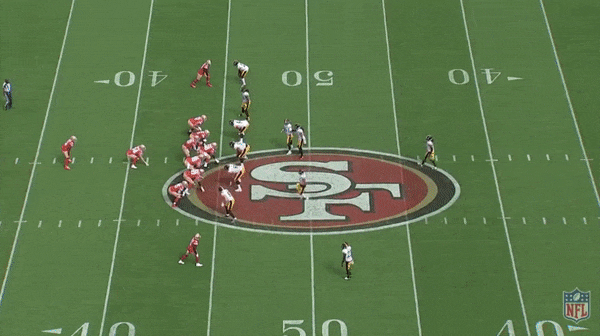
For someone who’s 240 pounds, Juszczyk is a shockingly effective big-play target. San Francisco averaged 9.96 yards per attempt on Juszczyk’s 24 targets this season, which certainly helped fuel the Niners’ healthy 9.7 yards per attempt out of 21 personnel. But their ruthless passing efficiency with Juszczyk on the field goes way beyond the occasional shot play. Throwing out of heavier personnel packages is typically an easy way for teams to exploit base defenses that keep three linebackers on the field. But Juszczyk is more than just a big body that helps dictate who’s on the field. Smart teams like New England regularly motion fullbacks out of the backfield to decipher coverage and create mismatches elsewhere (think the Patriots’ game-winning drive in last year’s Super Bowl). The difference is that when Juszczyk motions out wide, he isn’t just a decoy.
On this play midway through the first quarter against Green Bay, Juszczyk motions from the backfield to a wide receiver alignment on the right side. Because cornerback Kevin King follows Juszczyk toward the sideline, Garoppolo knows that he’s throwing into a zone defense. At the snap, Juszczyk runs a quick 5-yard in route, with Samuel running a deep dig behind him. Rather than ignoring the fullback, linebacker B.J. Goodson drives on Juszczyk, which frees up space for Garoppolo to rifle a throw to Samuel for a 30-yard catch and run.
Shanahan has a keen awareness of how often he has to run certain concepts to make them a credible threat. The Niners may not throw to Juszczyk much, but they do it enough to force defenses to account for him. Against the Seahawks in Week 17, Juszczyk lined up as a slot receiver on the right as part of a two-receiver look to that side. At the snap, Juszczyk released inside and got lost behind Kendricks for a huge 49-yard gain.
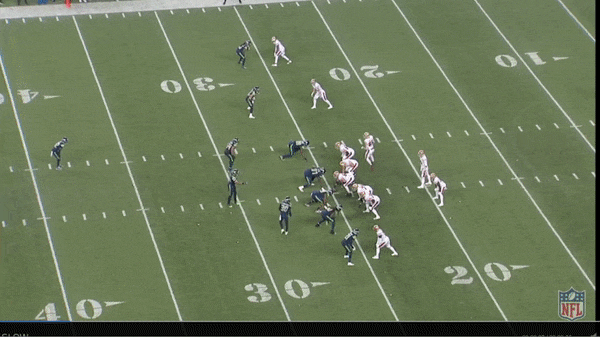
Juszczyk has been mostly relegated to blocking during the postseason, but in a potentially tight Super Bowl, it wouldn’t be a surprise to see Shanahan use his human Swiss army knife to rip off a game-swinging play. No matter what his receiving load, though, Juszczyk’s presence will change the Chiefs’ defensive constitution, the same way it has for opponents all season. His numbers may not blow anybody away, but his multidimensional role is central to the Niners’ identity.